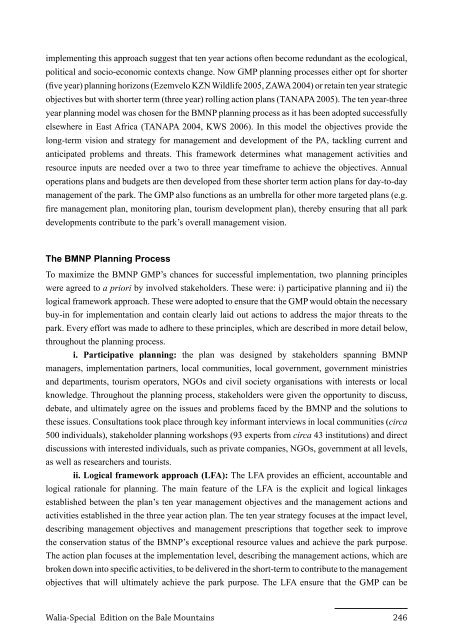Walia Special Edition on the Bale Mountains (2011) - Zoologische ...
Walia Special Edition on the Bale Mountains (2011) - Zoologische ...
Walia Special Edition on the Bale Mountains (2011) - Zoologische ...
Create successful ePaper yourself
Turn your PDF publications into a flip-book with our unique Google optimized e-Paper software.
implementing this approach suggest that ten year acti<strong>on</strong>s often become redundant as <strong>the</strong> ecological,<br />
political and socio-ec<strong>on</strong>omic c<strong>on</strong>texts change. Now GMP planning processes ei<strong>the</strong>r opt for shorter<br />
(five year) planning horiz<strong>on</strong>s (Ezemvelo KZN Wildlife 2005, ZAWA 2004) or retain ten year strategic<br />
objectives but with shorter term (three year) rolling acti<strong>on</strong> plans (TANAPA 2005). The ten year-three<br />
year planning model was chosen for <strong>the</strong> BMNP planning process as it has been adopted successfully<br />
elsewhere in East Africa (TANAPA 2004, KWS 2006). In this model <strong>the</strong> objectives provide <strong>the</strong><br />
l<strong>on</strong>g-term visi<strong>on</strong> and strategy for management and development of <strong>the</strong> PA, tackling current and<br />
anticipated problems and threats. This framework determines what management activities and<br />
resource inputs are needed over a two to three year timeframe to achieve <strong>the</strong> objectives. Annual<br />
operati<strong>on</strong>s plans and budgets are <strong>the</strong>n developed from <strong>the</strong>se shorter term acti<strong>on</strong> plans for day-to-day<br />
management of <strong>the</strong> park. The GMP also functi<strong>on</strong>s as an umbrella for o<strong>the</strong>r more targeted plans (e.g.<br />
fire management plan, m<strong>on</strong>itoring plan, tourism development plan), <strong>the</strong>reby ensuring that all park<br />
developments c<strong>on</strong>tribute to <strong>the</strong> park’s overall management visi<strong>on</strong>.<br />
The BMNP Planning Process<br />
To maximize <strong>the</strong> BMNP GMP’s chances for successful implementati<strong>on</strong>, two planning principles<br />
were agreed to a priori by involved stakeholders. These were: i) participative planning and ii) <strong>the</strong><br />
logical framework approach. These were adopted to ensure that <strong>the</strong> GMP would obtain <strong>the</strong> necessary<br />
buy-in for implementati<strong>on</strong> and c<strong>on</strong>tain clearly laid out acti<strong>on</strong>s to address <strong>the</strong> major threats to <strong>the</strong><br />
park. Every effort was made to adhere to <strong>the</strong>se principles, which are described in more detail below,<br />
throughout <strong>the</strong> planning process.<br />
i. Participative planning: <strong>the</strong> plan was designed by stakeholders spanning BMNP<br />
managers, implementati<strong>on</strong> partners, local communities, local government, government ministries<br />
and departments, tourism operators, NGOs and civil society organisati<strong>on</strong>s with interests or local<br />
knowledge. Throughout <strong>the</strong> planning process, stakeholders were given <strong>the</strong> opportunity to discuss,<br />
debate, and ultimately agree <strong>on</strong> <strong>the</strong> issues and problems faced by <strong>the</strong> BMNP and <strong>the</strong> soluti<strong>on</strong>s to<br />
<strong>the</strong>se issues. C<strong>on</strong>sultati<strong>on</strong>s took place through key informant interviews in local communities (circa<br />
500 individuals), stakeholder planning workshops (93 experts from circa 43 instituti<strong>on</strong>s) and direct<br />
discussi<strong>on</strong>s with interested individuals, such as private companies, NGOs, government at all levels,<br />
as well as researchers and tourists.<br />
ii. Logical framework approach (LFA): The LFA provides an efficient, accountable and<br />
logical rati<strong>on</strong>ale for planning. The main feature of <strong>the</strong> LFA is <strong>the</strong> explicit and logical linkages<br />
established between <strong>the</strong> plan’s ten year management objectives and <strong>the</strong> management acti<strong>on</strong>s and<br />
activities established in <strong>the</strong> three year acti<strong>on</strong> plan. The ten year strategy focuses at <strong>the</strong> impact level,<br />
describing management objectives and management prescripti<strong>on</strong>s that toge<strong>the</strong>r seek to improve<br />
<strong>the</strong> c<strong>on</strong>servati<strong>on</strong> status of <strong>the</strong> BMNP’s excepti<strong>on</strong>al resource values and achieve <strong>the</strong> park purpose.<br />
The acti<strong>on</strong> plan focuses at <strong>the</strong> implementati<strong>on</strong> level, describing <strong>the</strong> management acti<strong>on</strong>s, which are<br />
broken down into specific activities, to be delivered in <strong>the</strong> short-term to c<strong>on</strong>tribute to <strong>the</strong> management<br />
objectives that will ultimately achieve <strong>the</strong> park purpose. The LFA ensure that <strong>the</strong> GMP can be<br />
<str<strong>on</strong>g>Walia</str<strong>on</strong>g>-<str<strong>on</strong>g>Special</str<strong>on</strong>g> <str<strong>on</strong>g>Editi<strong>on</strong></str<strong>on</strong>g> <strong>on</strong> <strong>the</strong> <strong>Bale</strong> <strong>Mountains</strong> 246
















